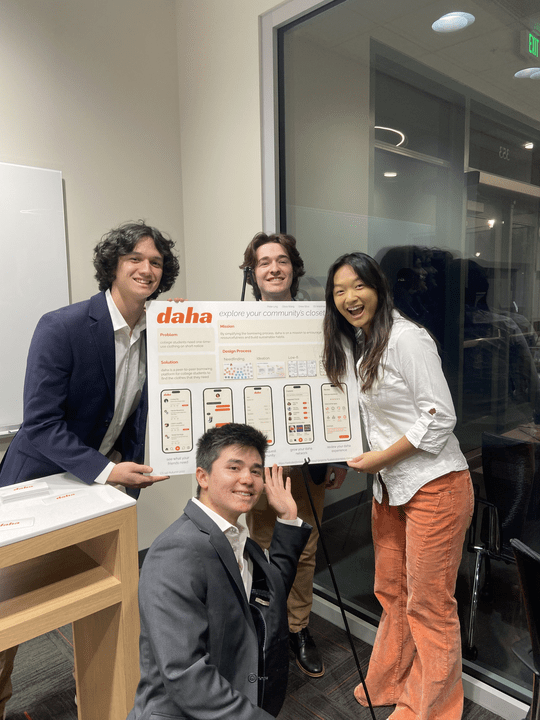DAHA stands for “Does Anyone Have A,” a ubiquitous Stanford acronym found in campus GroupMe chats, Slack channels and text threads to borrow items. The Daily sat down with Olivia Wang ’24 to learn about her experience developing daha, which is taking Stanford’s borrowing acronym and transforming it into a simplified platform designed for lending on college campuses, launching next fall.
This interview has been lightly edited for clarity.
The Stanford Daily [TSD]: What is daha’s elevator pitch?
Olivia Wang [OW]: We aim to simplify the borrowing process on campus. We help our peers turn away from one-time buys to support a circular economy on campus. Our tagline is to explore your community’s closet.
TSD: What is daha’s origin story?
OW: daha started in a CS 147 class: Introduction to Human-Computer Interaction Design. We came in not knowing what we were going to do, just that we would be designing and developing a product in class.
We signed up for a sustainability studio, which is a section of the class where your product is focused. We chose a domain of consumption and overconsumption online.
We then conducted interviews with college students and locals in the Bay Area about their consumption behavior. We discovered that people want to be sustainable, but it is more convenient and cheaper not to be. For college students, we found, people need one-time use items in a really short period of time.
This is why there are so many “daha” requests on texts. “daha” texts are something we send on the daily ourselves. Clearly, college students need things on a short notice, so we thought there was an opportunity to leverage that by using what already exists in the community. And we want to make it the best user experience possible — much easier than texting because daha is one platform with one request on a network with all your friends.
We have continued working with the same professor, James Landay, in CS194H, User Interface Design Project, this quarter.
TSD: Who is on your team? How did your team come together?
OW: Our team is me, Drew Silva ’24, Eli Waldman ’24 and Peter Ling ’24. Over the summer, we asked each other what classes we were taking in the fall, and we realized we were all taking CS 147 together. Before class started, we knew we wanted to build something together.
I think we complement each other really well. Peter and Drew have CS backgrounds, and Eli and I have SymSys backgrounds. Eli and I did more of the design, and Peter and Drew were critical in the development.
I didn’t want this project to compromise my close friendships with them, but we all care about this product, so it turns out it has been really easy to work with them.
TSD: How do you manage developing daha while also being a full-time student amid all the frenzy of college life?
OW: Because we’re working on this project through a class, it’s actually been convenient to be nudged with assignments, to always be pushing forward every week and to be receiving constant direct feedback from our peers and Professor Landay.
TSD: Who is your audience?
OW: We are focusing first on Stanford, making you verify an account with a Stanford email. It is supposed to be community-based to keep the trust in the community. We will start there and then look at other college campuses. There is currently no product out there for students in need of borrowing a one-time use item. But, “daha” is actually a Stanford-only term, so it will be interesting to see if it catches on.
TSD: What motivates you? How does daha relate to your long-term professional goals?
OW: I really want to build in the sustainable fashion industry. I feel like the fashion industry is ripe for change, and I want to be in the forefront of that movement and help in whatever ways I can. There is so much to be done with incorporating technology and design into promoting a circular economy. This is something I’m really passionate about, and daha has taught me a lot about consumer behavior and how to encourage people to buy less and buy better.
TSD: What has been the greatest success thus far?
OW: The biggest success personally has been putting my design skills to the test. This is the first product I am designing for users. The biggest success as a team has been bringing fun into work, having good energy and leaning into assignments. It has been so rewarding to see our work out there and share it with the class.
TSD: What about your biggest challenge?
OW: The biggest challenge has undoubtedly been trying to figure things out for the first time. We’re all first-time builders, so it’s been a hell of a ride. Things are definitely taking longer than expected — designing screens, translating our designs into fully-functioning code, testing our prototypes on users — but we are patient and excited for what’s to come.
